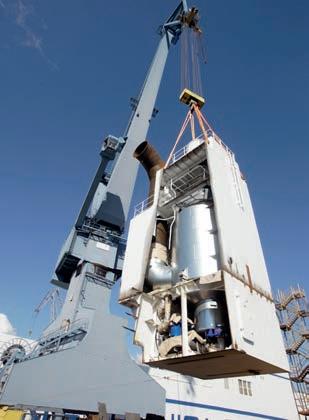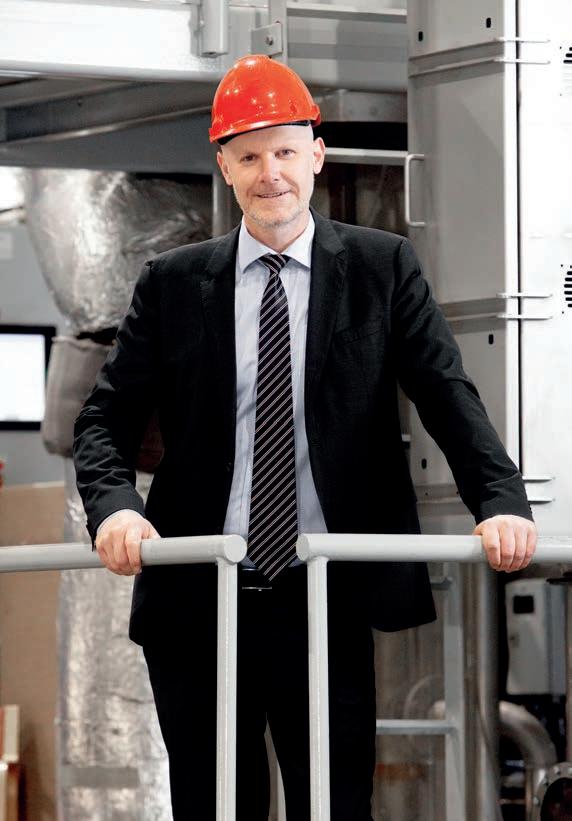
5 minute read
Future-proofing assets through
Future-proofng assets through innovation
ESTABLISHED IN 1834, WÄRTSILÄ HAS BEEN AT THE FRONTIER OF ENGINEERING INNOVATION FOR OVER 180 YEARS. BEING A LEADER IN SMART TECHNOLOGIES AND COMPLETE LIFECYCLE SOLUTIONS FOR THE MARINE AND ENERGY MARKETS, THE COMPANY EMPHASISES ON SUSTAINABLE INNOVATION, TOTAL EFFICIENCY, AND DATA ANALYTICS.
Advertisement
WORDS BY SIGURD JENSSEN, DIRECTOR OF WÄRTSILÄ EXHAUST TREATMENT. ALL PHOTOS COURTESY OF WÄRTSILÄ.
They aim to maximise the environmental and economic performance of the vessels and power plants of their customers. Sigurd Jenssen, Director at Wärtsilä Exhaust Treatment explains how there’s more to exhaust gas abatement technology than just SOx and how scrubbing technologies are an excellent platorm for future environmental innovaton.
As an environmental technology with the potential to grow further, there is no better example of proactive innovation than exhaust gas cleaning systems (EGCS), or scrubbers.
Sustainability
Wärtsilä has an important role in meetng the world’s increased demand for energy in a sustainable way. This is the cornerstone of their commitment to sustainability. This sustainability approach is based on economic, environmental, and social performance, striving to improve procedures and performance across a wide front. The overall focus is on ensuring proftability, providing environmentally sound products and services, and ensuring responsible business conduct.
A need for novel thinking
With environmental pressure intensifying rapidly and regulaton on a range of sustainability concerns – including black carbon, SOx, NOx, and Partculate Mater (PM) – coming in the near future, shipping must champion technology solutons that can tackle this wide and diverse set of challenges. With mountng pressure on our sector from consumers, investors, shippers, and regulators, it is clear that shipping faces an urgent challenge to unlock more sustainable operatons. Even if we had not all experienced the momentous shifs and changes that 2020 brought, there would have stll been a pressing and unprecedented requirement to change the way we operate and mitgate our impact on the planet. The context and impetus for wide-scale environmental change has never been clearer. This places huge strain on owners and operators, who are facing the overwhelming challenge of having to comply with current environmental regulatons whilst also planning for those that are likely to emerge in the future. What’s clear is that these challenges need widespread and novel thinking, and technological innovaton in a broad range of areas.
A favourable landscape for scrubbers
As an environmental technology with the potental to grow further, there is no beter example of proactve innovaton than exhaust gas cleaning systems (EGCS), or scrubbers. One potental soluton to the challenges of the future in our sector is embracing a new way of thinking about these technologies as solutons beyond just SOx and Sulphur Cap compliance. Instead, we should focus on their potental – which is already being realised – to tackle many of the key sustainability issues and regulatory requirements that we expect will be implemented in the very near future. Before focusing on future emissions requirements, it is worth exploring the success of scrubbers with regard to supportng the industry’s transiton to the 0.5% Global Sulphur Cap. The case for scrubbers contnues to go from strength to strength, with favourable economics matched by a growing body of in-operaton experience proving that they are an efectve soluton to cut SOx without any negatve impact on the marine environment. For owners and operators who have invested in scrubbers, the joint rewards of seamless compliance and an increasingly favourable fuel spread speak for themselves. In additon, newbuilding sentment for the technology is picking up, with the majority of containership, bulk carrier and tanker
owners optng for a mix of open loop and hybrid installatons on new additons to their feet. However, the case grows even stronger as we explore the technology’s ability to constantly evolve and, with contnued development, help solve both present challenges and emerging ones.

Carbon capture and storage
Stepping beyond sulphur, scrubbers are a platorm for a huge range of complimentary technology developments that, individually and combined, can tackle multple environmental challenges around the stack. This technology platorm uses the central positon of scrubbers in the propulsion and exhaust chain as a basis to incorporate new technologies to tackle a range of diferent emited substances. Contnuous innovaton can therefore improve the fexibility of the soluton, positvely impact ROI, and even beneft the most forward-thinking owners from a reputatonal perspectve. But what does this look like from a technical level? One area Wärtsilä is extensively exploring is how carbon capture and storage (CCS) can be developed and scaled in maritme. We are installing a 1MW pilot plant at our test facility in Moss, Norway to test our CCS technologies in a range of scenarios and conditons. Carbon capture and storage is excitng because it can be an integral tool in the toolbox to solve one of the biggest challenges of all in the short and medium term: directly mitgatng CO2 emissions. We can explore this because scrubbers and the knowledge gained from installing them gives us the right expertse to capture carbon at the point of exhaust. We can also do this – and, indeed, are exploring how scrubbers can be proactvely used – for a huge variety of pollutants, including NOx and partculate mater.
Time for an upgrade
The tming is right for this kind of technological innovaton because our industry’s regulatory landscape is only going in one directon when it comes to sustainability. Technology development can therefore play a crucial role in supportng owners’ and operators’ requirements to comply with more stringent environmental rules.
Sigurd Jenssen, Director of Wärtsilä Exhaust Treatment.
It is clear that scrubbers are no longer a soluton for a single sustainability challenge. Instead, more responsibility should be placed on the potental of these technologies to be upgraded over tme – efectvely safeguarding the crucial, obscure, and important investment decisions that owners are making today.










